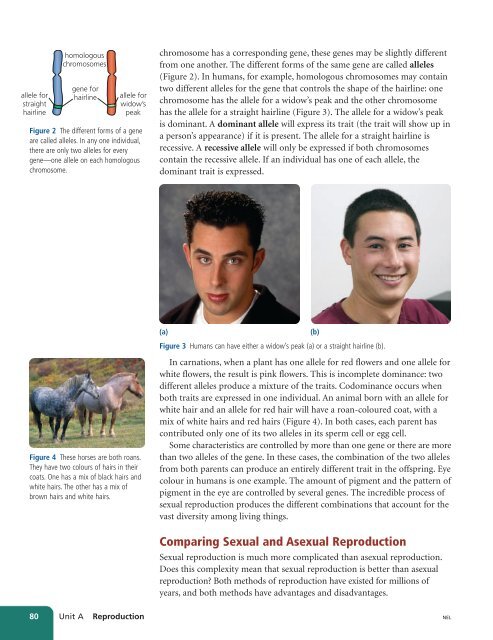Unit A Reproduction
Unit A Reproduction
Unit A Reproduction
You also want an ePaper? Increase the reach of your titles
YUMPU automatically turns print PDFs into web optimized ePapers that Google loves.
allele for<br />
straight<br />
hairline<br />
homologous<br />
chromosomes<br />
gene for<br />
hairline<br />
allele for<br />
widow’s<br />
peak<br />
Figure 2 The different forms of a gene<br />
are called alleles. In any one individual,<br />
there are only two alleles for every<br />
gene—one allele on each homologous<br />
chromosome.<br />
chromosome has a corresponding gene, these genes may be slightly different<br />
from one another. The different forms of the same gene are called alleles<br />
(Figure 2). In humans, for example, homologous chromosomes may contain<br />
two different alleles for the gene that controls the shape of the hairline: one<br />
chromosome has the allele for a widow’s peak and the other chromosome<br />
has the allele for a straight hairline (Figure 3). The allele for a widow’s peak<br />
is dominant. A dominant allele will express its trait (the trait will show up in<br />
a person’s appearance) if it is present. The allele for a straight hairline is<br />
recessive. A recessive allele will only be expressed if both chromosomes<br />
contain the recessive allele. If an individual has one of each allele, the<br />
dominant trait is expressed.<br />
(a)<br />
(b)<br />
Figure 3 Humans can have either a widow’s peak (a) or a straight hairline (b).<br />
Figure 4 These horses are both roans.<br />
They have two colours of hairs in their<br />
coats. One has a mix of black hairs and<br />
white hairs. The other has a mix of<br />
brown hairs and white hairs.<br />
In carnations, when a plant has one allele for red flowers and one allele for<br />
white flowers, the result is pink flowers. This is incomplete dominance: two<br />
different alleles produce a mixture of the traits. Codominance occurs when<br />
both traits are expressed in one individual. An animal born with an allele for<br />
white hair and an allele for red hair will have a roan-coloured coat, with a<br />
mix of white hairs and red hairs (Figure 4). In both cases, each parent has<br />
contributed only one of its two alleles in its sperm cell or egg cell.<br />
Some characteristics are controlled by more than one gene or there are more<br />
than two alleles of the gene. In these cases, the combination of the two alleles<br />
from both parents can produce an entirely different trait in the offspring. Eye<br />
colour in humans is one example. The amount of pigment and the pattern of<br />
pigment in the eye are controlled by several genes. The incredible process of<br />
sexual reproduction produces the different combinations that account for the<br />
vast diversity among living things.<br />
Comparing Sexual and Asexual <strong>Reproduction</strong><br />
Sexual reproduction is much more complicated than asexual reproduction.<br />
Does this complexity mean that sexual reproduction is better than asexual<br />
reproduction? Both methods of reproduction have existed for millions of<br />
years, and both methods have advantages and disadvantages.<br />
80 <strong>Unit</strong> A <strong>Reproduction</strong><br />
NEL

















